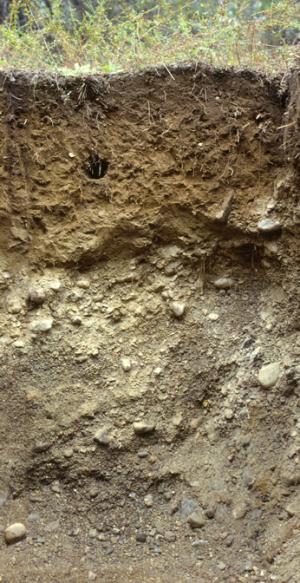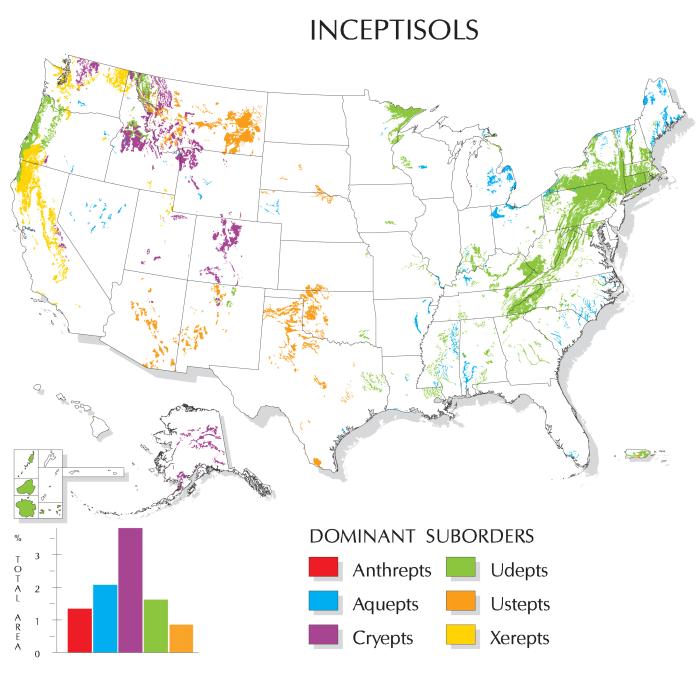Inceptisols
Inceptisols are soils of semiarid to humid environments that generally exhibit only moderate degrees of soil weathering and development.

The central concept of Inceptisols is that of soils of humid and subhumid regions that have altered horizons that have lost bases or iron and aluminum but retain some weatherable minerals. They do not have an illuvial horizon enriched with either silicate clay or with an amorphous mixture of aluminum and organic carbon.
The Inceptisols may have many kinds of diagnostic horizons, but argillic, natric kandic, spodic and oxic horizons are excluded.
Dominant Suborders
Anthrepts
Anthrepts are the more or less freely drained Inceptisols that have either an anthropic or plaggen epipedon. These soils are not known to occur in the United States.
Aquepts
Aquepts are the wet Inceptisols. Their natural drainage is poor or very poor, and, if the soils have not been artificially drained, ground water is at or near the soil surface at some time during normal years but typically not in all seasons. Many formed under forest vegetation, but they can have almost any kind of vegetation. Aquepts are used mostly as cropland, pasture, forest, or wildlife habitat.
Cryepts
Cryepts are the cold Inceptisols of high mountains or high latitudes. They are mostly in the high mountains of the West as well as southern Alaska. The vegetation is mostly conifers or mixed conifers and hardwoods. Most are used as forest or wildlife habitat. Some of the soils, mostly those in Alaska, are used as cropland.
Udepts
Udepts are mainly freely drained Inceptisols that have a udic or perudic moisture regime. They are most extensive in the Appalachian Mountains, on the Allegheny Plateau, in northeastern Minnesota, and in Oregon. Most of the soils currently support or formerly supported forest vegetation, but some support shrub or grass vegetation. The vegetation was mostly coniferous forest in the Northwest and mixed or hardwood forest in the Eastern States. Most are used as forest or have been cleared and are used as cropland or pasture.
Ustepts
Ustepts are freely drained Inceptisols that have an ustic moisture regime. They are most common on the Great Plains, mostly in Montana, Texas, and Oklahoma. The native vegetation commonly was grass, but some of the soils supported trees. Most Ustepts are used as cropland or pasture. Some are used as rangeland, forest, or wildlife habitat.
Xerepts
Xerepts are mainly freely drained Inceptisols that have a xeric moisture regime. They are in the western part of the United States, mostly in California, Oregon, and Washington. The native vegetation commonly was coniferous forest on the soils with a frigid or mesic temperature regime and shrubs, grasses, and widely spaced trees on the soils with a thermic temperature regime. Most Xerepts are used as forest, cropland, or pasture. Some are used as rangeland or wildlife habitat.

Inceptisols are soils of cool to very warm, humid and subhumid regions. The largest area is one that includes the southern New England States and the Appalachian Mountains. Other areas are on the southern Great Plains; in the Rocky Mountains; in eastern Montana; in the coastal and Cascade Mountains of California, Oregon, and Washington; and in northeastern Minnesota. Inceptisols have many kinds of diagnostic horizons and epipedons.

